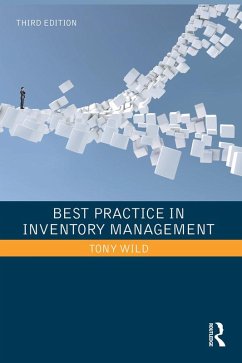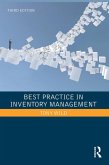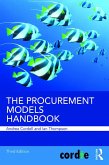Best Practice in Inventory Management (eBook, PDF)


Alle Infos zum eBook verschenken

Best Practice in Inventory Management (eBook, PDF)
- Format: PDF
- Merkliste
- Auf die Merkliste
- Bewerten Bewerten
- Teilen
- Produkt teilen
- Produkterinnerung
- Produkterinnerung

Hier können Sie sich einloggen

Bitte loggen Sie sich zunächst in Ihr Kundenkonto ein oder registrieren Sie sich bei bücher.de, um das eBook-Abo tolino select nutzen zu können.
Best Practice in Inventory Management 3E offers a simple, entirely jargon-free and yet comprehensive introduction to key aspects of inventory management. Good management of inventory enables companies to improve their customer service, cash flow and profitability. This text outlines the basic techniques, how and where to apply them, and provides advice to ensure they work to provide the desired effect in practice.
With an unrivalled balance between qualitative and quantitative aspects of inventory control, experienced consultant Tony Wild portrays the many ways in which stock management is…mehr
- Geräte: PC
- mit Kopierschutz
- eBook Hilfe
- Größe: 2.88MB
![Best Practice in Inventory Management (eBook, ePUB) Best Practice in Inventory Management (eBook, ePUB)]() Tony WildBest Practice in Inventory Management (eBook, ePUB)37,95 €
Tony WildBest Practice in Inventory Management (eBook, ePUB)37,95 €![Supply Chain Analytics (eBook, PDF) Supply Chain Analytics (eBook, PDF)]() Peter W. RobertsonSupply Chain Analytics (eBook, PDF)43,95 €
Peter W. RobertsonSupply Chain Analytics (eBook, PDF)43,95 €![The Procurement Models Handbook (eBook, PDF) The Procurement Models Handbook (eBook, PDF)]() Andrea CordellThe Procurement Models Handbook (eBook, PDF)33,95 €
Andrea CordellThe Procurement Models Handbook (eBook, PDF)33,95 €![Production Scheduling for the Process Industries (eBook, PDF) Production Scheduling for the Process Industries (eBook, PDF)]() Peter L. KingProduction Scheduling for the Process Industries (eBook, PDF)55,95 €
Peter L. KingProduction Scheduling for the Process Industries (eBook, PDF)55,95 €![Supply Chain Strategies (eBook, PDF) Supply Chain Strategies (eBook, PDF)]() Tony HinesSupply Chain Strategies (eBook, PDF)57,95 €
Tony HinesSupply Chain Strategies (eBook, PDF)57,95 €![An Introduction to Cybernetic Synergy (eBook, PDF) An Introduction to Cybernetic Synergy (eBook, PDF)]() Mark RowbothamAn Introduction to Cybernetic Synergy (eBook, PDF)51,95 €
Mark RowbothamAn Introduction to Cybernetic Synergy (eBook, PDF)51,95 €![Sustainable Logistics Systems Using AI-based Meta-Heuristics Approaches (eBook, PDF) Sustainable Logistics Systems Using AI-based Meta-Heuristics Approaches (eBook, PDF)]() Sustainable Logistics Systems Using AI-based Meta-Heuristics Approaches (eBook, PDF)42,95 €
Sustainable Logistics Systems Using AI-based Meta-Heuristics Approaches (eBook, PDF)42,95 €-
-
-
With an unrivalled balance between qualitative and quantitative aspects of inventory control, experienced consultant Tony Wild portrays the many ways in which stock management is more nuanced than simple "number crunching" and mathematical modelling.
This long-awaited new edition has been substantially and thoroughly updated.
The product of decades of experience and expertise in the field, Best Practice in Inventory Management 3E provides students and professionals, even those with no prior experience in the area, an unbiased and honest picture of what it takes to effectively manage stocks in a firm.
Dieser Download kann aus rechtlichen Gründen nur mit Rechnungsadresse in A, B, BG, CY, CZ, D, DK, EW, E, FIN, F, GR, HR, H, IRL, I, LT, L, LR, M, NL, PL, P, R, S, SLO, SK ausgeliefert werden.
- Produktdetails
- Verlag: Taylor & Francis eBooks
- Seitenzahl: 294
- Erscheinungstermin: 2. November 2017
- Englisch
- ISBN-13: 9781351865357
- Artikelnr.: 50136007
- Verlag: Taylor & Francis eBooks
- Seitenzahl: 294
- Erscheinungstermin: 2. November 2017
- Englisch
- ISBN-13: 9781351865357
- Artikelnr.: 50136007
- Herstellerkennzeichnung Die Herstellerinformationen sind derzeit nicht verfügbar.
.
PREFACE
INTRODUCTION
1 THE BASIS OF INVENTORY CONTROL
1.A The role of inventory management
1.B Objectives for inventory control
1.C Profit through inventory management
1.D Reasons for the current stock
2 CUSTOMER SERVICE
2.A Customer Relations
2.B Measuring availability
2.C Demand management
2.D Consuming forecast demand and supply lead time
3 SHAPING INVENTORY
3.A Using Pareto Analysis for control
3.B ABC Analysis
3.C Stock cover
3.D Pareto stock balance
4 PRACTICAL METHODS FOR REDUCING STOCKHOLDING
4.A Approach to Inventory Reduction
4.B The Reduction Project
4 C Obsolete and Excess Stock
5 MANAGEMENT AND CONTROL
5.A Where stock control fits into the organisation
5.B Responsibilities and targets
5.C Skills and Systems
5.D Inventory valuation
6 LEAN SUPPLY
6.A Lean Supply Philosophy
6.B Lean Principles
6.C Implementing lean
6.D Operational benefits of Lean Supply
6.E Developing Lean Operations
7 SAFETY STOCKS
7.A Learning from History
7.B Normal demand patterns
7.C Evaluating safety stocks
8 SETTING THE RIGHT STOCK LEVELS
8.A Simple Assessment of Review Levels
8.B Managing Lead Times
8.C Supplier Delivery frequency effects
8.D Target stock levels
9 PROCUREMENT
9.A The Role of Supply Chain Procurement
9.B Supply partnerships
9.C Single Sourcing
9.D Supply Partnerships
9.E Vendor Appraisal
9.F Pricing Methods
10 DELIVERY QUANTITIES
10.A Supply and Suppliers
10.B Organising Repetitive Supply
10.C Order types
10.D Order quantities
10.E Delivery Quantities
10.F Scheduling supply
10.G Supply Co-ordination
10.H Purchasing Processes
11 FORECASTING DEMAND
11.A Options for assessing demand
11.B Causes of forecasting inaccuracy
11.C Methods of improving forecasting
12 HISTORICAL FORECASTING TECHNIQUES
12.A Basic Forecasting Techniques
12.B Moving Average
12.C Exponentially Weighted Averages
12.D Improved Values for Mean Absolute Deviation
12.E Choosing the Best Forecast - Focus Forecasting
13 IMPROVED FORECASTING METHODS
13.A More Forecasting Tools
13.B Forecasting for seasonal sales
14 DEPENDENT DEMAND
14.A Avoiding uncertainty
14.B Material requirements planning
14.C Master planning
15 SUPPLY CHAIN INVENTORY MANAGEMENT
15.A The basis of the lean supply chain
15.B Coordination
15.C Supply Chain Operations
15.D Replenishment Techniques
16 MEETING THE CHALLENGES
16.A Review
16.B Recipe for success
QUESTIONS & ANSWERS
PREFACE
INTRODUCTION
1 THE BASIS OF INVENTORY CONTROL
1.A The role of inventory management
1.B Objectives for inventory control
1.C Profit through inventory management
1.D Reasons for the current stock
2 CUSTOMER SERVICE
2.A Customer Relations
2.B Measuring availability
2.C Demand management
2.D Consuming forecast demand and supply lead time
3 SHAPING INVENTORY
3.A Using Pareto Analysis for control
3.B ABC Analysis
3.C Stock cover
3.D Pareto stock balance
4 PRACTICAL METHODS FOR REDUCING STOCKHOLDING
4.A Approach to Inventory Reduction
4.B The Reduction Project
4 C Obsolete and Excess Stock
5 MANAGEMENT AND CONTROL
5.A Where stock control fits into the organisation
5.B Responsibilities and targets
5.C Skills and Systems
5.D Inventory valuation
6 LEAN SUPPLY
6.A Lean Supply Philosophy
6.B Lean Principles
6.C Implementing lean
6.D Operational benefits of Lean Supply
6.E Developing Lean Operations
7 SAFETY STOCKS
7.A Learning from History
7.B Normal demand patterns
7.C Evaluating safety stocks
8 SETTING THE RIGHT STOCK LEVELS
8.A Simple Assessment of Review Levels
8.B Managing Lead Times
8.C Supplier Delivery frequency effects
8.D Target stock levels
9 PROCUREMENT
9.A The Role of Supply Chain Procurement
9.B Supply partnerships
9.C Single Sourcing
9.D Supply Partnerships
9.E Vendor Appraisal
9.F Pricing Methods
10 DELIVERY QUANTITIES
10.A Supply and Suppliers
10.B Organising Repetitive Supply
10.C Order types
10.D Order quantities
10.E Delivery Quantities
10.F Scheduling supply
10.G Supply Co-ordination
10.H Purchasing Processes
11 FORECASTING DEMAND
11.A Options for assessing demand
11.B Causes of forecasting inaccuracy
11.C Methods of improving forecasting
12 HISTORICAL FORECASTING TECHNIQUES
12.A Basic Forecasting Techniques
12.B Moving Average
12.C Exponentially Weighted Averages
12.D Improved Values for Mean Absolute Deviation
12.E Choosing the Best Forecast - Focus Forecasting
13 IMPROVED FORECASTING METHODS
13.A More Forecasting Tools
13.B Forecasting for seasonal sales
14 DEPENDENT DEMAND
14.A Avoiding uncertainty
14.B Material requirements planning
14.C Master planning
15 SUPPLY CHAIN INVENTORY MANAGEMENT
15.A The basis of the lean supply chain
15.B Coordination
15.C Supply Chain Operations
15.D Replenishment Techniques
16 MEETING THE CHALLENGES
16.A Review
16.B Recipe for success
QUESTIONS & ANSWERS
PREFACE
INTRODUCTION
1 THE BASIS OF INVENTORY CONTROL
1.A The role of inventory management
1.B Objectives for inventory control
1.C Profit through inventory management
1.D Reasons for the current stock
2 CUSTOMER SERVICE
2.A Customer Relations
2.B Measuring availability
2.C Demand management
2.D Consuming forecast demand and supply lead time
3 SHAPING INVENTORY
3.A Using Pareto Analysis for control
3.B ABC Analysis
3.C Stock cover
3.D Pareto stock balance
4 PRACTICAL METHODS FOR REDUCING STOCKHOLDING
4.A Approach to Inventory Reduction
4.B The Reduction Project
4 C Obsolete and Excess Stock
5 MANAGEMENT AND CONTROL
5.A Where stock control fits into the organisation
5.B Responsibilities and targets
5.C Skills and Systems
5.D Inventory valuation
6 LEAN SUPPLY
6.A Lean Supply Philosophy
6.B Lean Principles
6.C Implementing lean
6.D Operational benefits of Lean Supply
6.E Developing Lean Operations
7 SAFETY STOCKS
7.A Learning from History
7.B Normal demand patterns
7.C Evaluating safety stocks
8 SETTING THE RIGHT STOCK LEVELS
8.A Simple Assessment of Review Levels
8.B Managing Lead Times
8.C Supplier Delivery frequency effects
8.D Target stock levels
9 PROCUREMENT
9.A The Role of Supply Chain Procurement
9.B Supply partnerships
9.C Single Sourcing
9.D Supply Partnerships
9.E Vendor Appraisal
9.F Pricing Methods
10 DELIVERY QUANTITIES
10.A Supply and Suppliers
10.B Organising Repetitive Supply
10.C Order types
10.D Order quantities
10.E Delivery Quantities
10.F Scheduling supply
10.G Supply Co-ordination
10.H Purchasing Processes
11 FORECASTING DEMAND
11.A Options for assessing demand
11.B Causes of forecasting inaccuracy
11.C Methods of improving forecasting
12 HISTORICAL FORECASTING TECHNIQUES
12.A Basic Forecasting Techniques
12.B Moving Average
12.C Exponentially Weighted Averages
12.D Improved Values for Mean Absolute Deviation
12.E Choosing the Best Forecast - Focus Forecasting
13 IMPROVED FORECASTING METHODS
13.A More Forecasting Tools
13.B Forecasting for seasonal sales
14 DEPENDENT DEMAND
14.A Avoiding uncertainty
14.B Material requirements planning
14.C Master planning
15 SUPPLY CHAIN INVENTORY MANAGEMENT
15.A The basis of the lean supply chain
15.B Coordination
15.C Supply Chain Operations
15.D Replenishment Techniques
16 MEETING THE CHALLENGES
16.A Review
16.B Recipe for success
QUESTIONS & ANSWERS
PREFACE
INTRODUCTION
1 THE BASIS OF INVENTORY CONTROL
1.A The role of inventory management
1.B Objectives for inventory control
1.C Profit through inventory management
1.D Reasons for the current stock
2 CUSTOMER SERVICE
2.A Customer Relations
2.B Measuring availability
2.C Demand management
2.D Consuming forecast demand and supply lead time
3 SHAPING INVENTORY
3.A Using Pareto Analysis for control
3.B ABC Analysis
3.C Stock cover
3.D Pareto stock balance
4 PRACTICAL METHODS FOR REDUCING STOCKHOLDING
4.A Approach to Inventory Reduction
4.B The Reduction Project
4 C Obsolete and Excess Stock
5 MANAGEMENT AND CONTROL
5.A Where stock control fits into the organisation
5.B Responsibilities and targets
5.C Skills and Systems
5.D Inventory valuation
6 LEAN SUPPLY
6.A Lean Supply Philosophy
6.B Lean Principles
6.C Implementing lean
6.D Operational benefits of Lean Supply
6.E Developing Lean Operations
7 SAFETY STOCKS
7.A Learning from History
7.B Normal demand patterns
7.C Evaluating safety stocks
8 SETTING THE RIGHT STOCK LEVELS
8.A Simple Assessment of Review Levels
8.B Managing Lead Times
8.C Supplier Delivery frequency effects
8.D Target stock levels
9 PROCUREMENT
9.A The Role of Supply Chain Procurement
9.B Supply partnerships
9.C Single Sourcing
9.D Supply Partnerships
9.E Vendor Appraisal
9.F Pricing Methods
10 DELIVERY QUANTITIES
10.A Supply and Suppliers
10.B Organising Repetitive Supply
10.C Order types
10.D Order quantities
10.E Delivery Quantities
10.F Scheduling supply
10.G Supply Co-ordination
10.H Purchasing Processes
11 FORECASTING DEMAND
11.A Options for assessing demand
11.B Causes of forecasting inaccuracy
11.C Methods of improving forecasting
12 HISTORICAL FORECASTING TECHNIQUES
12.A Basic Forecasting Techniques
12.B Moving Average
12.C Exponentially Weighted Averages
12.D Improved Values for Mean Absolute Deviation
12.E Choosing the Best Forecast - Focus Forecasting
13 IMPROVED FORECASTING METHODS
13.A More Forecasting Tools
13.B Forecasting for seasonal sales
14 DEPENDENT DEMAND
14.A Avoiding uncertainty
14.B Material requirements planning
14.C Master planning
15 SUPPLY CHAIN INVENTORY MANAGEMENT
15.A The basis of the lean supply chain
15.B Coordination
15.C Supply Chain Operations
15.D Replenishment Techniques
16 MEETING THE CHALLENGES
16.A Review
16.B Recipe for success
QUESTIONS & ANSWERS







